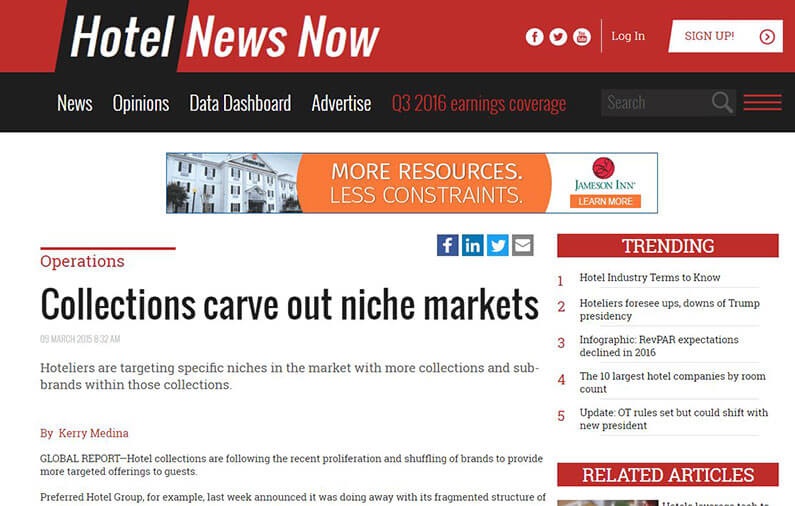Hotel Filter
Download here our complete hotel directory
By publication
By Date
Collections carve out niche markets

2015
09
Mar
Hoteliers are targeting specific niches in the market with more collections and sub-brands within those collections.
GLOBAL REPORT—Hotel collections are following the recent proliferation and shuffling of brands to provide more targeted offerings to guests.
Preferred Hotel Group, for example, last week announced it was doing away with its fragmented structure of seven standalone brands by folding them under one corporate umbrella and reorganizing member hotels into one of five new collections: Legend, LVX, Lifestyle, Connect and Preferred Residences.
(Previously the group comprised individual brands Preferred Hotels & Resorts; Preferred Residences; Preferred Boutique; Sterling Hotels; Sterling Design; Summit Hotels; and Summit Residences.)
The move coincides with a larger rebranding from Preferred Hotel Group to Preferred Hotels & Resorts.
“Driven by evolving consumer expectations and changing travel trends, our new brand architecture creates stronger clarity for the Preferred Hotels & Resorts brand within the marketplace and allows us to elevate and focus attention on our world-class collection of independent hotels and resorts,” said Lindsey Ueberroth, president and CEO.
Member hotels are assigned a designation to one of the five aforementioned categories based on a fixed set of 10 criteria, she explained. “We’re clarifying in light of what everyone else is doing, and that will have an impact in and of itself.”
A growing collective
The hotel industry for years has become more entrenched in the realm of so-called collections, which allow owners to maintain some degree of independence while benefitting from the distribution and marketing of a larger corporate entity.
At least three entrants were announced in 2014:
- Quorvus Collection (Carlson Rezidor Hotel Group);
- Curio – A Collection by Hilton (Hilton Worldwide Holdings); and
- BW Premier Collection (Best Western International).
More recently, National Geographic Unique Lodges of the World launched with an inaugural portfolio of 24 sustainable properties across six continents.
And Frits van Paasschen, former CEO of Starwood Hotels & Resorts Worldwide, announced the company was launching a more affordably priced collection to add to the group’s existing roster of The Luxury Collection and Design Hotels.
“This new offering will allow us to plug in unbranded properties that meet the quality expectations of our core SPG travelers and broaden our ability to grow and reach an even broader segment of travelers,” van Paasschen said during an earnings call with analysts.
There appears no shortage of independent properties potentially seeking affiliations from either traditional hotel brands or marketing affiliation groups such as Preferred, according to Renie Cavallari, founder and CEO of Phoenix-based marketing consultancy Aspire.
“It makes perfect sense that so many hotel collections are coming to the market right now because people want that unique lifestyle experience,” she said. “I think (the market) can support more. … There’s opportunity because there aren’t any clear winners or top performers in this segment.”
Cavallari pointed to Kimpton Hotels & Restaurants and Joie de Vivre as branding leaders in so far as each company’s ability to create recognizable identities for its respective group of hotels without the hallmarks of a chain.
“Both have done a lot around creating brands with a unique lifestyle experience, and they really capture the essence of the independent lifestyle model. But I think there is still room for someone to really take the lead on hotel collections and do what it will take to stand out,” Cavallari said.
Julius Robinson, VP of Marriott International’s Autograph Collection, shared a similar view, citing two factors driving the popularity of collections and the independent hotels comprised therein.
First is the “the millennial mindset, in terms of travelers looking for the customizable and unique experiences that are clearly trends in this space.” The second is “the aging boomer population who, retired, is traveling and looking for unique experiences that differ from the traditional hotels where they stayed for business throughout their careers.
“Put those two worlds together, and it speaks to a strong future for the independent hotel space,” Robinson said.
A niche focus
Preferred Hotels is not the only collection to organize its offerings into more tailored market niches.
Leading Hotels of the World launched Leading Spas and Leading Golf in 2005 and 2010, respectively.
And although German-based Healing Hotels of the World doesn’t label its member hotels under sub-collections per se, it does allows website users to explore the collection by 14 categories such as Detox, Yoga and Ayurveda, explained CEO Anne Biging.
(Healing Hotels does have one bona fide sub-brand called “Urban Hotels,” which launched in 2012 for business travelers. Otherwise, Biging said member properties can be found in multiple categories depending on their offerings.)
Other collections are already niche in focus and don’t require further deviations.
Puerto Vallarta-based Mexico Boutique Hotels has been curating a collection of independent, boutique properties, all located in a single country since 1999.
“MBH was created in Mexico and operates exclusively in Mexico, meaning we have an understanding of local culture that is not comparable to the Mexico offerings of other hotel collections in terms of knowledge and authenticity,” said Operations Director Miguel Andres Hernandez Arteaga.
“Sub-collections were trendy some years ago,” he added, going so far as to say that in the past MBH has had guests request some form of segmentation. But executives decided not to segment, focusing instead on increasing communications and building rapport with hotel members, guests and the communities where member hotels are located.
Marriott’s Autograph Collection executive team does not subscribe to the sub-collection strategy either, Robinson said.
“We gave sub-collections some thought early on in the birth of the collection … but the unique branding of each hotel tells the story of its experience, and we don’t want to give the consumer the pre-conceived notion that the hotel is only about spa or only about exploration or sustainability.
“But if the collection becomes five times larger than it is today,” he added, “we may consider sub-collections to help the consumer understand where they are.”
See original source HERE

